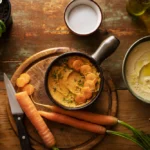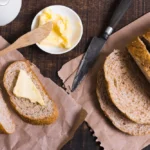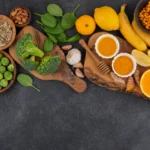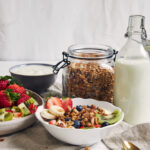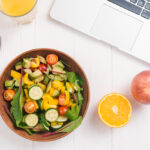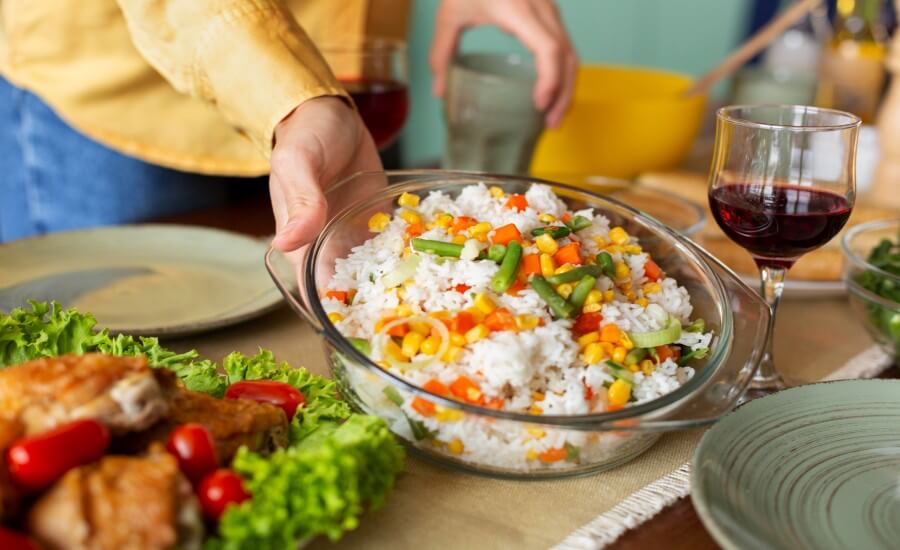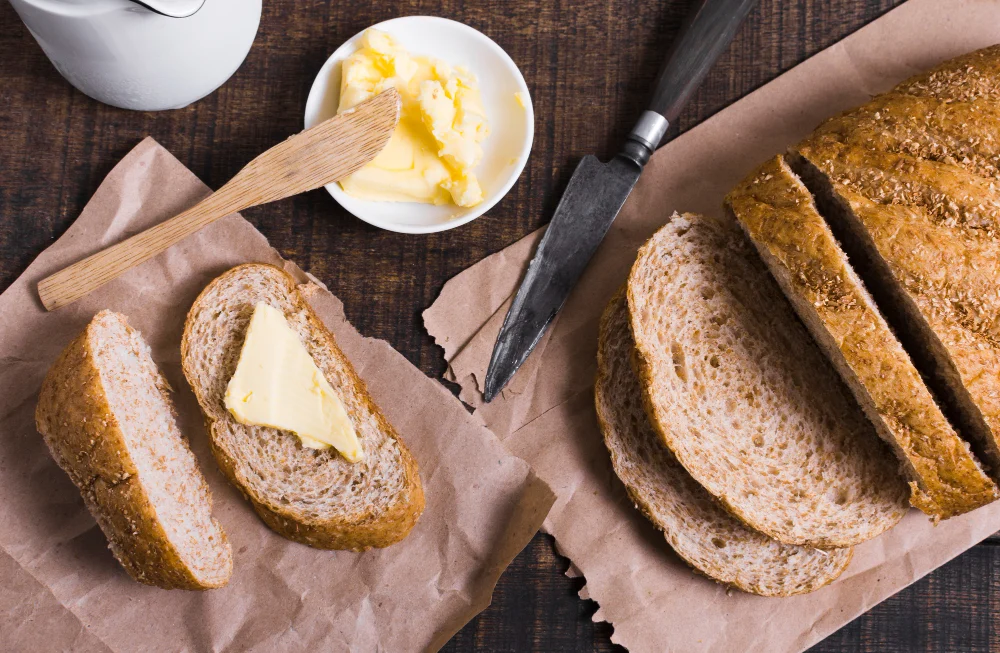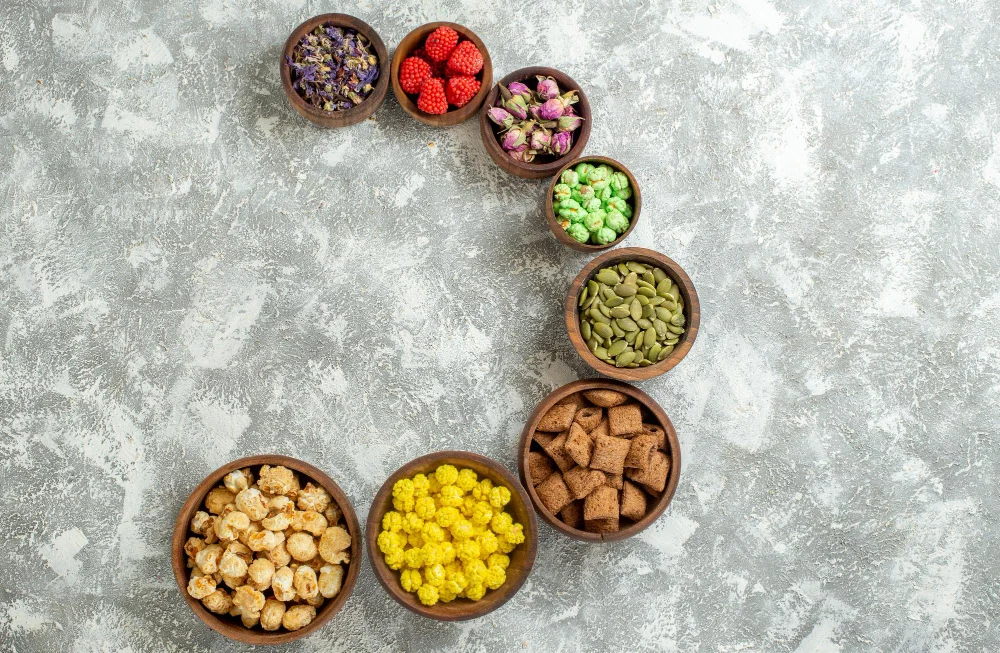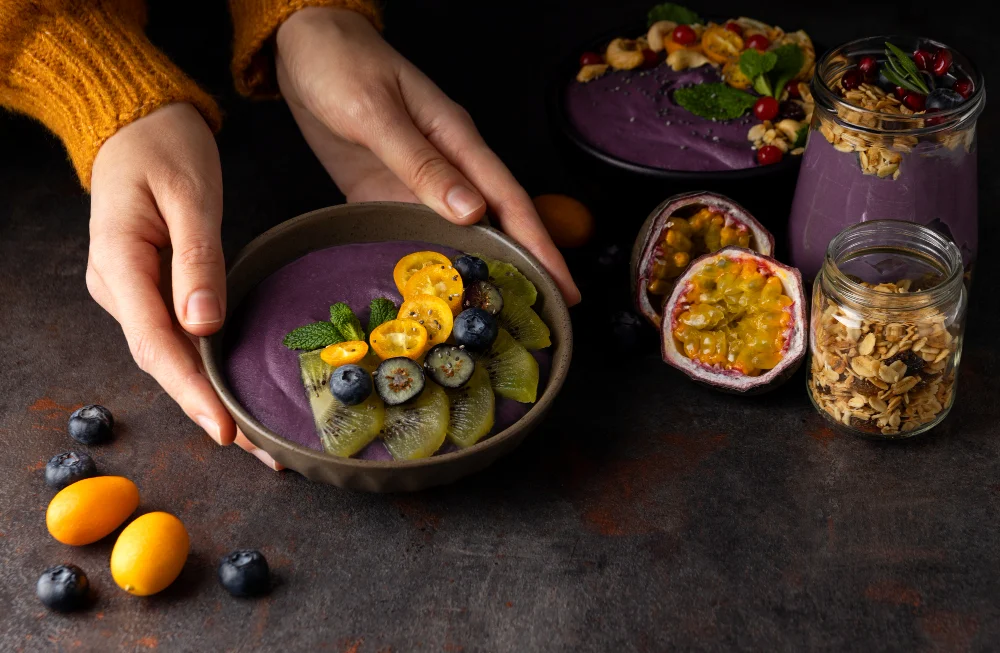Rice bowls – or grain bowls – have taken the culinary world by storm, offering a versatile, customizable, and visually appealing way to enjoy a complete meal. Their beauty lies in their adaptability, making them perfect for crafting incredibly satisfying and filling vegan rice bowl recipes. Far from being just a random assortment of leftovers, a well-constructed vegan rice bowl is a balanced, nutrient-dense powerhouse. This guide explores the art and science of building substantial and delicious vegan rice bowls, viewed through the lenses of nutrition, ethics, environment, and practical home cooking, offering inspiration and ideas adaptable globally and specifically utilizing the ingredients and flavours found here in Jaipur and across India.
Hearty Vegan Rice Bowls: Nutritious Recipes to Satisfy
LENS 1: Nutritional Analysis (Balanced Bowls of Goodness)

The key to a filling vegan rice bowl lies in its nutritional balance, ensuring sustained energy, satiety, and a broad range of micronutrients.
- The Formula for Fullness: Think modularly:
- Base (Complex Carbs & Fiber): While white rice is common, opt for brown rice for significantly more fiber and nutrients. Better yet, explore traditional Indian grains like millets (bajra, jowar, ragi, foxtail – often more nutritious and suited to Rajasthan’s climate) or quinoa. These provide sustained energy release.
- Protein (Satiety Power): This is crucial for making the bowl truly filling. Include generous portions of cooked legumes like chickpeas (chana), kidney beans (rajma), black-eyed peas (lobia), lentils (dal – served thick, not too soupy), baked or pan-fried tofu/tempeh, edamame, or even a sprinkle of nuts and seeds.
- Vegetables (Volume, Fiber, Nutrients): Load up! Include a variety of colourful vegetables prepared in different ways – raw (like in kachumber salad – chopped cucumber, tomato, onion), steamed, roasted (peppers, cauliflower, sweet potato), stir-fried (quick sabzi style), or simply wilted greens (spinach/palak). Use seasonal vegetables available in Jaipur (in May/June: tomatoes, onions, cucumbers, gourds like lauki/tori, okra/bhindi, cluster beans/guar phali, bell peppers).
- Healthy Fats (Satiety & Absorption): Fats slow digestion, contributing significantly to feeling full. Include sliced avocado, a sprinkle of pumpkin/sunflower/sesame seeds, chopped nuts (peanuts/almonds), or a dressing based on tahini, nut butter, or healthy oils (used moderately). Fats also help absorb fat-soluble vitamins from the vegetables.
- Flavor Elements: Sauces, dressings, chutneys, pickles (achar), fresh vegan herbs (coriander/dhania, mint/pudina), and spices tie everything together and make the bowl exciting.
- Nutritional Synergy: Combining these elements ensures a good balance of macronutrients (carbs, protein, fat), high fiber content, and a wide array of vitamins and minerals essential for energy and overall health. Remember to ensure adequate Vitamin B12 intake through fortified foods or supplements as part of your overall vegan diet. How can you combine protein, fiber, and healthy fats in your next rice bowl to maximize its staying power?
Nutritional Deep Dive: The Satiety Factor – Why Protein, Fiber & Fat Keep You Full
Feeling full and satisfied after a meal (satiety) is influenced by several factors:
- Protein: Takes longer to digest than carbohydrates and influences hormones related to fullness (like PYY and GLP-1). Including adequate protein (legumes, tofu, nuts/seeds) is key for making a bowl feel substantial.
- Fiber: Adds bulk to the meal, slows stomach emptying, and helps regulate blood sugar, preventing rapid hunger pangs. Whole grains, legumes, vegetables, nuts, and seeds are packed with fiber.
- Fat: Slows down digestion significantly and triggers the release of satiety hormones (like CCK). Healthy fats from avocado, nuts, seeds, and oils contribute greatly to the feeling of fullness. A bowl combining all three – like brown rice (fiber/carb), chana (protein/fiber), roasted vegetables (fiber/vitamins), and an avocado-tahini dressing (fat/flavor) – will keep you satisfied much longer than a bowl of just plain rice and simple veg.
Voice of Experience (Clinical Nutritionist): “Vegan rice bowls are a fantastic framework for building balanced meals. To make them truly filling and nutritious, ensure you include a good source of plant protein like beans, lentils or tofu, plenty of non-starchy vegetables for volume and fiber, a whole grain base, and a source of healthy fat from dressings, nuts, or seeds. This combination promotes satiety and provides sustained energy.” – Divya Rathore, MSc (Food & Nutrition)
LENS 2: Ethical Framework (Conscious Bowl Building)

Building a vegan rice bowl offers numerous opportunities to practice conscious consumption and ethical eating habits.
- Ingredient Sourcing: Choose Fair Trade certified rice, quinoa, coffee (for mocha bowls?), or spices where possible. Prioritize purchasing local, seasonal vegetables directly from farmers at Jaipur’s mandis, supporting the local economy and reducing reliance on long, complex supply chains. Select ethically produced tofu or plant proteins from companies with transparent practices.
- Food Waste Warrior: Rice bowls are the ultimate way to combat food waste ethically. They beautifully accommodate:
- Leftover cooked grains (rice, millets, quinoa)
- Leftover roasted or steamed vegetables
- Small amounts of cooked beans or lentils (dal)
- Half an avocado, a handful of nuts
- Odds and ends of sauces or dressings
- Wilting greens (sauté or add to the base) This honours the resources used to produce the food.
- Accessibility & Dignity: Using affordable staples like rice, dal, chana, and seasonal vegetables makes nourishing, satisfying vegan meals accessible across different income levels, upholding the dignity associated with good food for everyone.
- Sharing & Community: Preparing components for rice bowls can facilitate sharing meals with family or friends, allowing everyone to customize their bowl – a modern take on communal eating often seen in Indian culture. How can you use the rice bowl format this week to creatively reduce food waste in your kitchen?
Hidden Benefits: Reduced Decision Fatigue & Creative Outlet
Having a go-to meal format like a rice bowl (Grain + Protein + Veg + Fat + Flavor) reduces daily decision fatigue about “what to eat.” Simultaneously, the customizable nature provides a constant outlet for culinary creativity based on available ingredients.
Voice of Experience (Zero Waste Chef): “Rice bowls are my secret weapon against food waste! Leftover rice? Check. That half bell pepper? Check. Those slightly sad greens? Sauté ’em! A handful of chana? Perfect. Drizzle with tahini dressing, and you have a delicious, ethical, zero-waste meal. It’s about respecting every ingredient.” – Chef Anand Kumar, “Sustainable Kitchen” Jaipur
Critical Reassessment: The ‘Bowl’ Trend & Accessibility
While celebrating creativity, be mindful that the highly curated, often expensive “Buddha Bowls” seen on social media, featuring imported ingredients like quinoa or avocado year-round, aren’t always accessible or sustainable for everyone. Ground the concept in using affordable, local staples first and foremost.
LENS 3: Ingredient Science & Environment (Sustainable Foundations)
The components of your vegan rice bowl have varying environmental impacts, offering opportunities for sustainable choices.
- The Grain Base:
- Rice: Traditional white or brown rice cultivation, especially paddy rice, is water-intensive and can release significant methane (a potent GHG).
- Millets (Bajra, Jowar, Ragi, etc.): These ancient grains are often far more drought-resistant, require fewer inputs, and are exceptionally well-suited to arid/semi-arid climates like Rajasthan, making them a highly sustainable base choice locally.
- Quinoa: While nutritious, its popularity has led to increased transport distances (food miles) for consumers outside South America and potential socioeconomic impacts in growing regions.
- Protein Power: Legumes (lentils/dal, chickpeas/chana, beans/rajma) are environmental superstars, fixing their own nitrogen (reducing fertilizer needs) and having very low water and land footprints compared to animal proteins. Tofu’s footprint is also significantly lower than meat.
- Vegetable Vibes: Choosing local, seasonal vegetables dramatically reduces transport emissions and supports regional biodiversity. Avoiding out-of-season produce requiring heated greenhouses or long cold storage saves energy.
- Sauces & Fats: Homemade sauces reduce packaging waste. Sourcing oils locally (mustard, groundnut, sunflower) is often more sustainable than imported olive oil or avocados, depending on transport. Nuts like cashews and almonds have high water footprints. Seeds like sunflower/pumpkin are often more sustainable choices for fats/crunch.
- Bulk Buying: Purchasing grains and legumes in bulk significantly reduces packaging waste. Could you try swapping rice for a local millet like bajra or jowar as the base for your next bowl?
Market Transformation Map Suggestion: Data showing the increasing promotion and availability of various types of millets in Indian markets and restaurants, driven by government initiatives and consumer interest in health/sustainability.
Voice of Experience (Agricultural Scientist, Rajasthan): “Promoting millets like bajra and jowar as alternatives to rice in daily meals, including rice bowls, is crucial for sustainable food security in Rajasthan. These crops are climate-resilient, require far less water, thrive in local conditions, and are highly nutritious. They represent a return to environmentally sound traditional food systems.” – Dr. S. K. Sharma, CAZRI Jodhpur (hypothetical link)
LENS 4: Everyday Practitioner’s Experience (Recipes, Assembly & Customization)
Building filling vegan rice bowls at home is all about preparation, layering, and customization.
Building Your Bowl – The Formula:
- Choose Your Base (1 part): Cooked brown rice, white rice, quinoa, bajra, jowar, other millets, or even cauliflower rice. Tip: Cook grains in vegetable broth for extra flavour.
- Pick Your Protein (1 part): Spiced roasted chickpeas (chana), thick lentil dal (like Dal Makhani or simple Tadka Dal), kidney beans (rajma masala), black beans, baked/pan-fried/air-fried tofu cubes (marinated first!), tempeh strips, edamame.
- Load Up on Veggies (2+ parts): Combine raw, cooked, or pickled:
- Raw: Chopped cucumber/tomato/onion (kachumber), shredded carrots, cabbage slaw, leafy greens (spinach, lettuce).
- Cooked: Roasted vegetables (sweet potato, cauliflower, peppers, broccoli), steamed greens, simple stir-fried sabzi (using seasonal Jaipur veg like bhindi, lauki, tori), sautéed mushrooms.
- Pickled/Fermented: Indian pickles (achar – mango, lemon, chili), pickled onions, kimchi, sauerkraut.
- Add Healthy Fats (1/2 part): Sliced avocado, handful of toasted nuts (peanuts, almonds) or seeds (pumpkin, sunflower, sesame/til), dollop of hummus, tahini dressing.
- Drizzle/Dollop Flavor (Sauce/Dressing): Tahini-lemon dressing, peanut sauce, vegan raita (using plant yogurt + cucumber/spices), simple vinaigrette, green chutney (coriander-mint), tamarind chutney, a spoonful of flavourful curry sauce, hot sauce.
- Garnish (Optional): Fresh coriander/dhania, mint/pudina, toasted seeds, crushed peanuts, fried onions, sev (crunchy chickpea noodles).
Recipe Ideas (Combinations):
- Jaipur Summer Bowl: Bajra base + Spiced Black-Eyed Peas (Lobia) + Sautéed Okra (Bhindi) + Kachumber Salad (cucumber, tomato, onion) + Mint-Coriander Chutney.
- Hearty Rajma Bowl: Brown Rice + Rajma Masala (Kidney Bean Curry) + Steamed Spinach (Palak) + Pickled Onions + Vegan Raita.
- Tofu Teriyaki Bowl: Rice or Quinoa + Baked/Fried Teriyaki Tofu + Steamed Broccoli & Carrots + Edamame + Sesame Seeds + Teriyaki Glaze/Peanut Sauce.
- Mediterranean Bowl: Quinoa or Farro + Roasted Chickpeas & Zucchini/Peppers + Hummus + Cucumber-Tomato-Parsley Salad + Lemon-Tahini Dressing + Olives.
- Deconstructed Samosa Bowl: Rice + Spicy Potato & Pea Filling (Aloo Matar) + Crumbled Baked Samosa Pastry (optional) + Green Chutney + Tamarind Chutney + Chopped Onion/Coriander.
Meal Prep Tips:
- Cook a large batch of your chosen grain base at the start of the week.
- Roast a big tray of mixed vegetables.
- Cook a large batch of beans or lentils, or prepare tofu/tempeh.
- Chop raw vegetables for salads/toppings.
- Whisk together 1-2 dressings/sauces and store in jars.
- Assemble bowls quickly each day using prepped components.
What combination of grain, protein, vegetables, and sauce sounds most appealing to you right now?
Daily Impact: The “Fridge Clean-Out” Bowl
Designate one meal a week (e.g., Friday lunch) as a “fridge clean-out bowl” day. Assemble a bowl using whatever leftover grains, cooked vegetables, beans, greens, and sauce remnants need using up. Delicious, reduces waste, and requires minimal effort.
Voice of Experience (Busy Student): “Vegan rice bowls are my go-to! I cook a big pot of rajma or chana and some rice on Sunday. Then during the week, I just heat those up, chop some quick salad like cucumber and tomato, maybe add some peanuts or sev for crunch, and I have a filling, cheap, and healthy meal in minutes.” – Aarav Joshi, University Student, Jaipur
Alternative Approaches: Salad Style & Breakfast Bowls
- Rice Salads: Use cooled rice or grains as a base for substantial salads, tossing all components together with a vinaigrette.
- Breakfast Bowls: Savory bowls with rice/millet, tofu scramble, avocado, and greens, or sweet bowls with rice/oats, fruit, nuts, seeds, and plant milk/yogurt.
PERSPECTIVE INTERSECTION MATRIX
- Nutrition & Customization (Lens 1 & 4): The customizable nature of bowls (Lens 4) allows individuals to easily tailor meals to meet specific nutritional needs (protein, fiber, micronutrients) (Lens 1).
- Ethics & Leftovers (Lens 2 & 4): The ethical goal of reducing food waste (Lens 2) is perfectly facilitated by the practical format of using leftovers creatively in bowls (Lens 4).
- Environment & Base Choice (Lens 3 & 4): Choosing environmentally appropriate grains like local millets (Lens 3) is a practical decision made during bowl preparation (Lens 4).
- Science & Satiety (Lens 3 & 1/4): Understanding the science of satiety (role of protein/fiber/fat) (Lens 1/3) informs the practical construction of filling bowls (Lens 4).
- Practicality & All Goals (Lens 4 & 1/2/3): The ease of preparation and customization (Lens 4) makes rice bowls an effective vehicle for achieving nutritional balance (Lens 1), ethical eating (Lens 2), and sustainable food choices (Lens 3).
MISCONCEPTION ANALYSIS
| Misconception | Reality |
| Rice bowls are just a trendy way to eat random leftovers. | While great for leftovers, well-planned rice bowls are balanced, composed meals with distinct components working together. The format encourages variety and thoughtful combination. |
| Vegan rice bowls can’t be truly filling or provide enough protein. | They are easily made filling and protein-rich by including substantial portions of legumes (dal, chana, rajma), tofu, tempeh, nuts/seeds, and using whole grains. Fiber and healthy fats also contribute significantly to satiety. |
| Building a nice rice bowl is too complicated for a quick meal. | With prepped components (cooked grains, beans, chopped veg, ready sauce), assembling a bowl takes only minutes. Even from scratch, simple versions with dal, rice, and quick sabzi/salad are fast. |
| Rice bowls get boring – it’s always the same thing. | The beauty is infinite customizability! Change the grain, protein, vegetables (seasonally!), sauce, toppings, and flavour profile (Indian, Mexican, Thai, Mediterranean…) to keep things constantly new and exciting. |
| Healthy bowls must use expensive ingredients like quinoa or avocado. | Absolutely not! Extremely healthy and filling bowls can be built using affordable staples like rice or local millets (bajra), lentils (dal), chickpeas (chana), seasonal vegetables, and simple homemade dressings or chutneys. |
KEY TURNING POINTS
- Global Influence: Popularity of traditional bowl meals from various cultures (e.g., Japanese Donburi, Korean Bibimbap, Hawaiian Poke bowls – adapted vegan) spreading globally.
- “Buddha Bowl” Trend: Wellness culture popularizing the concept of beautifully arranged, plant-centric bowls often emphasizing whole foods.
- Meal Prep Movement: Rise of meal prepping favouring component-based cooking, perfectly suited to assembling bowls quickly throughout the week.
- Focus on Customizable Dining: Restaurants and fast-casual eateries offering build-your-own bowl options, increasing mainstream familiarity.
- Celebration of Plant-Based Staples: Renewed appreciation for the versatility and nutrition of grains, legumes, and vegetables as star components rather than just side dishes.
SYNTHESIS & RECOMMENDATIONS
Filling vegan rice bowls are more than just a trend; they represent a versatile, satisfying, and intelligent approach to plant-based eating. By combining a wholesome grain base, substantial plant protein, abundant colourful vegetables, healthy fats, and vibrant flavour elements, you can easily create meals that are nutritionally complete, ethically conscious, environmentally mindful, and incredibly delicious. Their customizable nature makes them perfect for using seasonal produce, incorporating leftovers creatively, and catering to individual tastes and dietary needs. Embrace the bowl format as a framework for convenient, creative, and consistently satisfying vegan meals.
Recommendations for Building Better Bowls:
- Follow the Formula: Build your bowl around Grain + Protein + Veggies (lots!) + Healthy Fat + Flavor.
- Prioritize Protein & Fiber: Ensure adequate legumes, tofu, or other protein, plus high-fiber grains and vegetables for lasting fullness.
- Embrace Seasonal & Local: Use vegetables that are in season in your area (visit your local mandi!). Try local grains like millets instead of or alongside rice.
- Prep Components: Cook grains, roast vegetables, prepare proteins, and make dressings ahead of time for quick assembly.
- Don’t Forget Flavor & Texture: Use sauces, dressings, spices, herbs, pickles (achar!), and crunchy toppings (seeds, nuts, sev) to make your bowls exciting.
- Get Creative with Leftovers: See leftovers not as repeats, but as components for your next unique bowl creation.
- Balance is Key: Aim for a variety of colours, textures, and flavours in each bowl for maximum appeal and nutrition.
- Customize to You: Adjust components and flavours based on your preferences, dietary needs, and what you have on hand.
FURTHER AREAS OF EXPLORATION
- A Guide to Cooking Indian Millets (Bajra, Jowar, Ragi) for Bowls
- 10+ Vegan Bowl Sauce & Dressing Recipes
- Meal Prepping Strategies Specifically for Vegan Bowls
- Building The Perfect Vegan Breakfast Bowl (Sweet & Savory)
- Using Fermented Foods (Kimchi, Sauerkraut, Pickles) in Vegan Bowls
- The Art of the ‘Fridge Clean-Out’ Bowl: Tips & Ideas
- Global Inspirations for Vegan Bowl Combinations (Thai, Mexican, African etc.)

